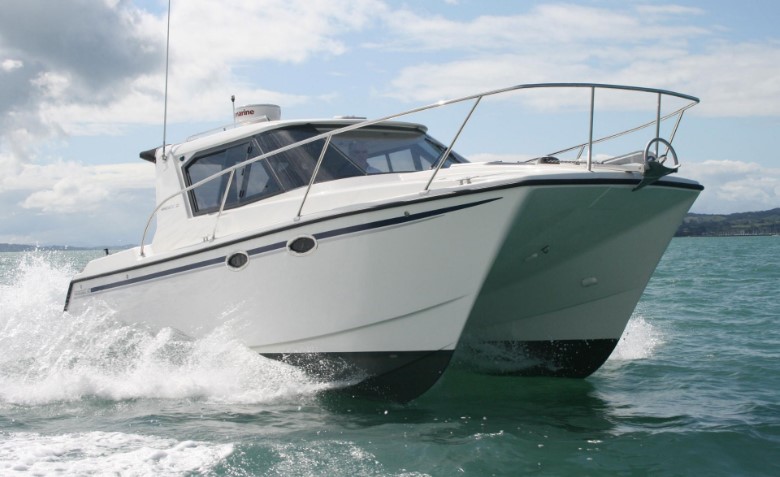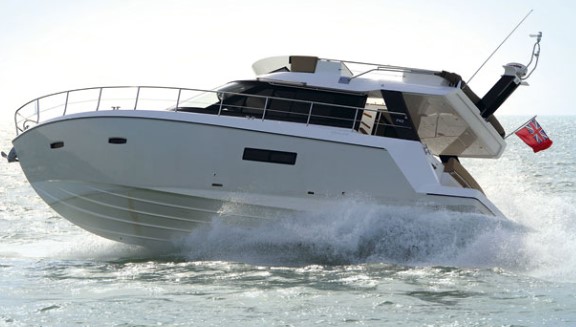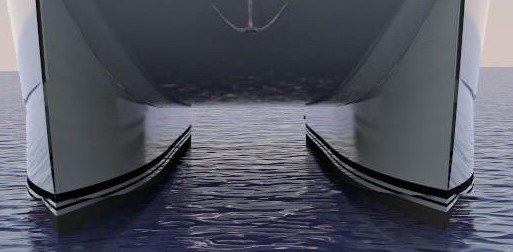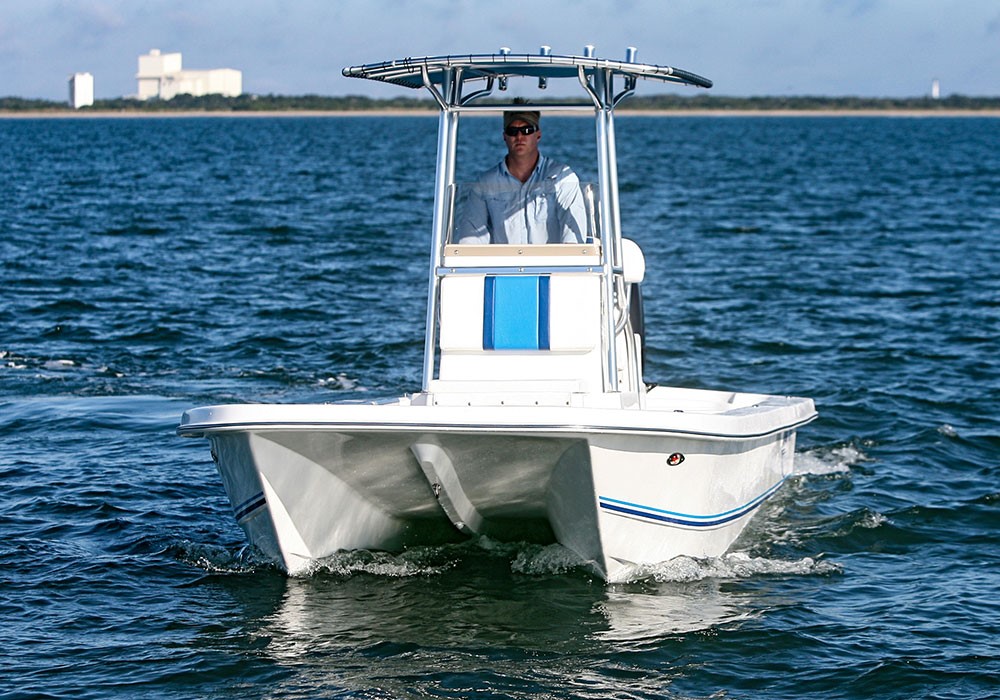How to Handle a Power Catamaran
Powercats and their brethren tunnel boats are all over the place today. You’ll see them on the flats, in the bays and in the blue water, and well out of sight of land. These twin-hull boats offer many advantages over monohulls, though they offer some disadvantages as well. The cat-versus-mono debate has been driven into the ground through years of discourse, but whichever hull design you favor the basic argument can be boiled down to this: Powercats usually display superior efficiency and stability, a softer ride and more deck space than a monohull, but they look ugly, feel strange when turning, may snap-roll, and cost more than monohulls.
Which is “better?” Neither, either and both — it depends on which factors are more or less important to you personally, and that’s a choice no one else can make for you. Whether you love them or hate them, run a cat like a traditional monohull and you’ll almost certainly be disappointed by the results. Often, a test drive with a salesman who doesn’t understand how to properly run a twin-hulled or tunnel boat turns a potential cat-lover away from the fold. Here’s what you need to know about captaining a cat, to prevent that from happening to you.
Trim – On a cat, trimming is nothing like a monohull. Most cats run most efficiently with a neutral trim, though tucking the bow in just a hair in rough seas can help smooth out the ride. If the boat is “sneezing” (sending puffs of mist out of the tunnel and soaking the passengers) there’s a good chance you have the motor trimmed in too much.
Of course, just as every monohull is different, every cat is different. Some run best with the bow trimmed up in a following sea and trimmed down (again — just slightly in most cases) with a head sea. Others continue to perform best at neutral trim. And with some powercats, changing the trim setting has little to no effect on ride at all. On such boats, simply set it for the most efficient fuel burn.
How do you know which setting to try for the particular boat you’re interested in? You’ll have to experiment since no rule of thumb is 100 percent accurate. So, you have a place to start, bear in mind that cats which displace less and plane more tend to act more like monohulls. Those who displace more and plane less tend to act more differently.
Turning – While monohulls bank into a turn, cats often remain flat and some even bank outwards. While this doesn’t present any real problem, it does catch people off-guard simply because it feels strange and unexpected, especially to experienced boaters who have always run monohulls.
On single-engine cats, this strange feeling is just something you’ll have to learn to live with. Take heart in the fact that after a season or two, it will feel every bit as natural as turning a monohull ever did. On twin-screw cats, however, you can mitigate the phenomenon by trimming up the outboard engine as you go into the turn. This will help bring that side of the boat up, keep the inboard side down, and will replicate the inward bank of a monohull.
Setting Speed – In a monohull, when the going gets tough and the trim has been properly set, there’s only one way to smooth out the ride — slow down. Oddly, in a cat this may have the opposite effect. Chopping the throttle can cause the boat to pound and slap, and ending the pounding is probably why you were interested in twin hulls in the first place. What gives? A powercat gets its smooth ride from the cushion of air compressed between the two hulls.
Look at virtually every modern cat and you’ll notice that the tunnel grows smaller as you move aft. The shrinking tunnel, combined with speed, compresses air and provides that cushion. At times, in certain sea conditions, going faster will help build that cushion and reduce impacts. Naturally, you have to use caution when speeding up in rough seas, but it’s an option that should be explored when the going gets tough.
Weight Matters – One of the most important, often overlooked factors in how a cat rides is load. The thin hulls found beneath the deck are driven deeper into the water by adding weight, which often produces “tunnel slap” (when the top of the tunnel slams down onto the waves.) While the softness of the ride on many monohulls improves with additional weight, when it comes to cats, the quality of the ride deteriorates quickly as weight grows.
Avoiding Snap Roll – The snap roll phenomenon is one of the worst attributes of powercats. These boats are exceptionally stable, but in some ways, too stable. When one hull drops off into a trough as the other rises on a wave the rocking motion is greatly exaggerated. What makes the motion even worse is the fact that people often become accustomed to riding on the incredibly stable platform, relax their handholds, and are caught off guard by the sudden shift.
The captain can, however, mitigate this problem by simply paying attention to the seas. Snap rolls are most often caused by boat wakes, thanks to their even spacing and height. When at the helm of a powercats, you must always be on the lookout for boat wakes approaching the beam. A slight course change to take the waves from a different angle is usually all it takes to completely eliminate a snap roll.
Mind the Bow – The vast majority of modern powercat designs feature very fine entries. As a result, cats tend to have relatively low buoyancy forward. This has two potential results. At certain low speeds in heavy head seas many cats throw spray, tunnel slap, and sometimes take water over the bow because the bow doesn’t have enough buoyancy to rise up and over the waves. At faster speeds, the air being shoved into the tunnel makes up for the lack of buoyancy.
Usually, this occurs between 1500 and 2000 rpm; the exact point at which it happens varies from cat to cat. The solution to this problem is to simply avoid running the boat into a head sea at this rpm range. When slowing down to investigate a fishing spot, or when approaching a waypoint, either come all the way back to idle or keep on just enough throttle to keep the bow slightly raised.
Stay Open-Minded – Most importantly, when running a cat, you need to remain open-minded and be willing to experiment. Every boat is different. Even boats of the exact same model can run differently, thanks to load, engine mounting, and a plethora of other factors. If you’re not willing to try running an unfamiliar boat many, many different ways until you discover how it runs best, you’re likely to be disappointed.
In my cat, it seems to like a slightly different trim setting each and every time I run it, depending on sea conditions and how many passengers and how much gear I have onboard. But if I make the effort, I can usually dial in the best running attitude and speed in a matter of one or two minutes. Once this is accomplished, I know from experience that it will provide a softer ride than any monohull of a comparable length. The fact that cats can do so has been proven numerically, as well as anecdotally.
I have been involved in cat-versus-mono testing, where boats were run side by side in identical conditions, while monitored with an accelerometer. This device interfaces with a laptop, and measures impacts and G-forces. Time and time again, the powercat posts drastically reduced impacts when that is, it is being operated properly. When driven improperly, the same tests prove that a cat’s ability to smooth out the ride is cut by more than half.




